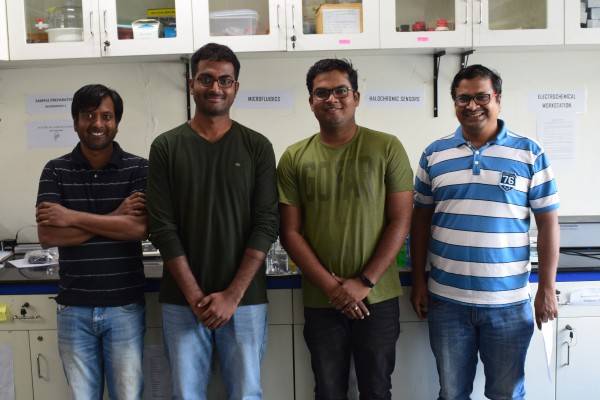
Milk consumption is more than the milk available hence in many places milk is adulterated or contaminated, which is very harmful to our body. Though there are many devices available in the market to detect milk contamination but people don’t know how to use them as it is complicated.
Indian Institute of Technology Hyderabad Researchers has developed a Smart Phone-based sensors to detect adulteration in milk. As a first step, they have developed a detector system to measure the acidity of milk through design of an indicator paper that changes color according to the acidity of the milk. They have also developed algorithms that can be incorporated on to a mobile phone to accurately detect the color change.
The research team has developed a sensor-chip based method for measuring pH, an indicator of the acidity and have used a process called ‘electrospinning’ to produce paper-like material made of nanosized (~10-9 m diameter) fibers of nylon, loaded with a combination of three dyes. The paper is “halochromic”, that is, it changes color in response to changes in acidity.

They have also developed a prototype smart phone-based algorithm, in which, the colours of the sensor strips after dipping in milk are captured using the camera of the phone, and the data is transformed into pH (acidity) ranges.
The research, undertaken by a team led by Professor Shiv Govind Singh, has been published in the November 2018 issue of Food Analytical Methods journal. "While techniques such as chromatography and spectroscopy can be used to detect adulteration, such techniques generally require expensive setup and are not amenable to miniaturization into low-cost easy-to-use devices. Hence, they do not appeal to the vast majority of milk consumers in the developing world," Singh said.
He added that there is a need to develop simple devices that consumers can use to detect milk contamination. "It should be possible to make milk adulteration detection failsafe by monitoring all of these parameters at the same time, without the need for expensive equipment," he said. The prototype smartphone-based algorithm analyses the colour of the sensor strips that are dipped in milk and then captured using the phone's camera. This is then converted into pH (acidity) ranges. On testing with milk spiked with various combinations of contaminants, the team found near-perfect classification with accuracy of 99.71 percent, the statement said. The team will extend the research to study the effects of mobile phone cameras and lighting on detection efficiency.

In the long run, the team hopes to develop sensors for other physical properties such as conductivity and refractive indexsmartphone-based and integrate it with the pH detection unit to obtain comprehensive milk quality check systems that can be easily deployed by the consumer using mobile phones and other hand-held devices. The statement cited a recent report by the Animal Welfare Board that stated that 68.7 percent of milk and milk by-products in the country are adulterated with items like detergent, glucose, urea, caustic soda, white paint and oil. Chemicals such as formalin, hydrogen peroxide, boric acid and antibiotics could also be added to milk to increase shelf life.
The research by a team of researchers comprising of Prof. Shiv Govind Singh, Department of Electrical Engineering, IIT Hyderabad, Dr. Soumya Jana and Dr. Siva Rama Krishna Vanjari, Associate Professors in the Department of Electrical Engineering, IIT Hyderabad and others, has been published in the November 2018 issue of Food Analytical Methods journal.
In the long run, the team hopes to develop sensors for other physical properties such as conductivity and refractive index and integrate it with the pH detection unit to obtain comprehensive milk quality check systems that can be easily deployed by the consumer using mobile phones and other hand-held devices.















